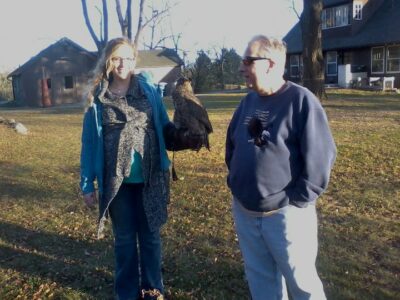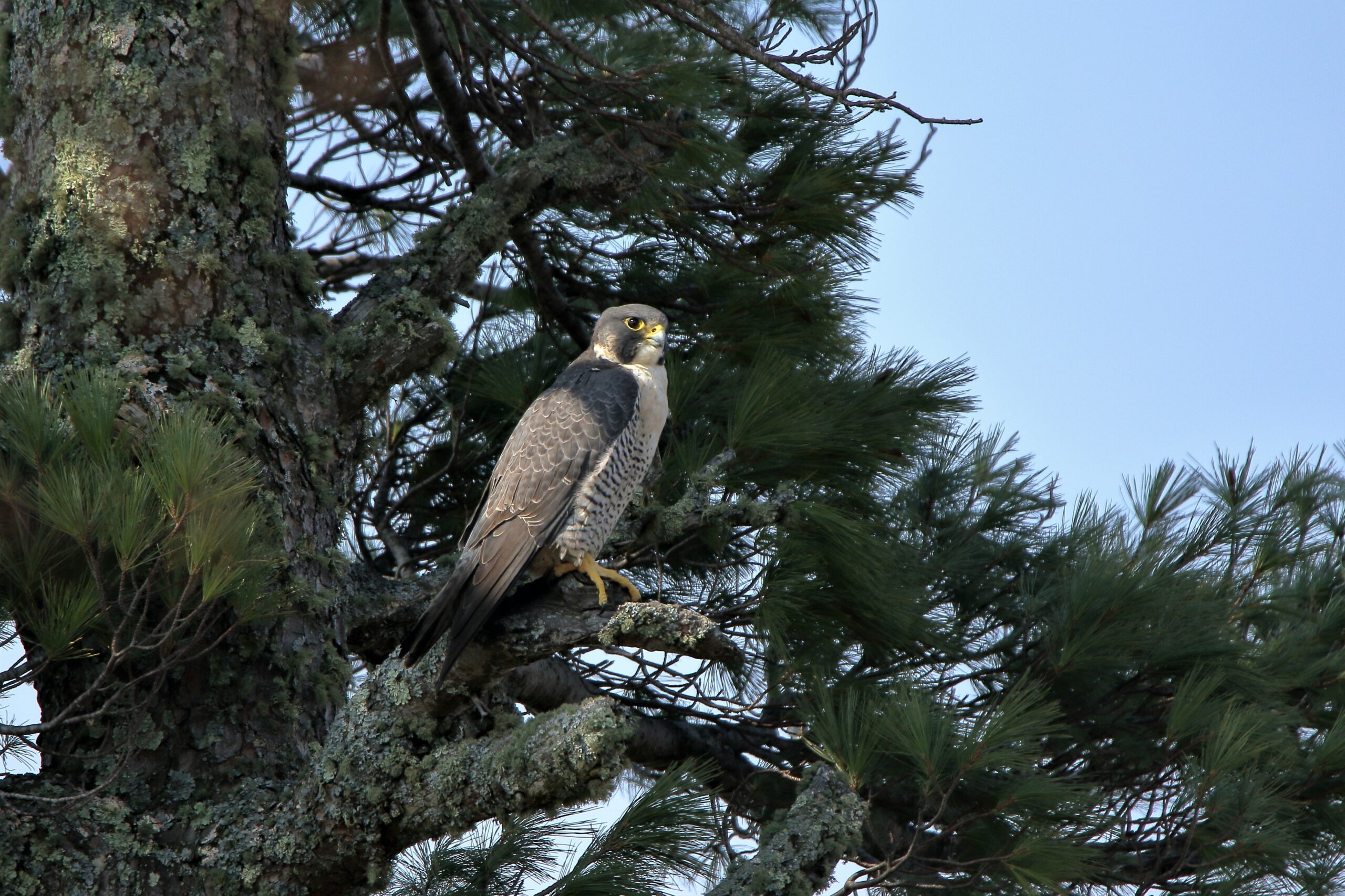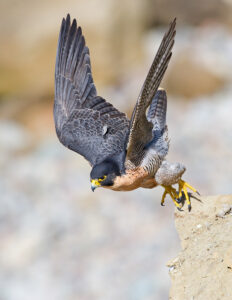Globally speaking, the Peregrine Falcon is an exceptionally widespread species. Its broad range reflects the translated meaning of the word peregrinus in Latin, or “wanderer.” Outside of the breeding season, the peregrine is quite the far-ranging traveler, earning them notoriety as one of the most well-known birds of prey in the world.
Adapting to urban as well as wild areas, breeding pairs of peregrines in Michigan have been successful. They have learned to adapt their nests to human constructs (buildings, bridges, smokestacks, radio and clock towers, and the like). Surveyors of this species scan these sites for perching peregrines searching for food. The easy-to-spot, diurnal peregrine is a treat for birdwatchers.
Identifying a Peregrine Falcon
- With a wingspan of 41 inches and about the size of a crow, the peregrine is a relatively large falcon.
- Females are larger than males; both have a blue-grey back, barred white underparts, and an almost black head. Juveniles are heavily marked, with vertical streaks instead of horizontal bars on the breast1.
- The barring of the peregrine feather pattern makes for visual similarities to Merlins.
The Status of “The Wanderer” in the Great Lakes State
In Michigan, the Peregrine Falcon remains on the state endangered species list, which affords them additional legal protections beyond the federal Migratory Bird Treaty Act. The Peregrine Falcon is not, at present, a federally listed endangered species, and its global rank is considered secure2.
Peregrine Falcons are migratory birds, but many will overwinter in Michigan cities if they have an ample population of Rock Pigeons to sustain them through the season.
Surveying for Peregrine Falcons
A big push was made by the U.S. Fish and Wildlife Service to reestablish the Peregrine Falcon population in Michigan after it was listed on the state’s endangered species list, and the agency continues to monitor this bird of prey statewide.
Surveying for peregrines involves visually scanning for individuals during the daytime from the fourth week of March to the fourth week of August annually. For birders, the best way to contribute to monitoring is to participate in local and regional migration counts and breeding bird surveys, and to enter their sightings into eBird.
In addition to increased monitoring efforts, which have been largely collaborative in nature with other groups and individuals like citizen scientists, Audubon chapters, and other nonprofit organizations, the Michigan Department of Natural Resources also established (and reached) their goal to maintain a population of at least 10 nesting pairs of Peregrine Falcons in Michigan.
With this goal met, monitoring continues, as does the outreach and education efforts required to better share with people how they can help us better understand, appreciate, and conserve the Peregrine Falcon.
Conservation Concerns for the Peregrine Falcon
In the 1960s, we saw the Peregrine Falcon population reach a critical low. It’s no doubt that the alarms sounded for improved legislation and protection to prevent this species from extinction. Conservation and legislative efforts have helped these birds recover, which is a success for birds, people, the ecosystem, and our monitoring systems.
However, the peregrine is still frequently sought after and illegally killed, in addition to the continual risks and pressures to adapt to climate change effects, habitat loss, and the myriad impacts of human disturbance.
- Illegal killing of peregrines to prevent predation on game birds and racing pigeons.
- The impact of pesticides in the food chain, which bioaccumulate (amplify) in birds of prey like the peregrine.
- The taking of eggs and chicks of peregrines worldwide for collections and falconry purposes.
Protecting Peregrines: Citizen Science Helps
Populations of the Peregrine Falcon have been reestablished in areas where the species had disappeared after the pesticide DDT caused breeding failures. You can help the Peregrine Falcon by making bird-friendly lifestyle choices, such as not using pesticides, buying organic whenever possible, and abstaining from the use of rodenticides (rat and mouse poisons) in your home and property. You can also help the peregrine monitoring effort with eBird. By sharing your sighting with the eBird community, you help us better protect this captivating species.
Getting Started With eBird3
Create a free account: Your account will work with other Cornell Lab projects!
Take the eBird essentials course: This free, self-paced course covers the basics for you.
Submit birding checklists: This can be done through the ebird.org website or by using the eBird mobile app.
Explore sightings anywhere: Check out species maps and hotspots observations, get rare or target species alerts, and more.
Follow eBird best practices: From submitting complete lists to the accuracy of location, there are several things you can do to make your data more valuable.
Learn more about these steps at support.ebird.org.
~ by Heather Good, Michigan Audubon executive director
Featured photo: Peregrine Falcon by Teresa McGill
References
1. https://mnfi.anr.msu.edu/species/description/10952/Falco-peregrinus
2. https://www.allaboutbirds.org/guide/Peregrine_Falcon/id#
3. https://support.ebird.org/en/support/solutions/articles/48001158707-get-started-with-ebird

Heather’s love for birds began with woodpeckers in childhood. She worked for a wild bird supply store during her undergraduate years; studied Environment & Sustainability Studies at Western Michigan University; and worked with birds of prey at Portland Audubon’s Wildlife Care Center, as an independent rehabilitator of birds of prey in southeast Michigan, and as a volunteer for the Leslie Science and Nature Center’s education bird program from 2009 to 2015. She became Michigan Audubon’s executive director in 2016 and is passionate about sharing and conserving birds of prey.
This article appeared in the 2022 Winter Jack Pine Warbler.


